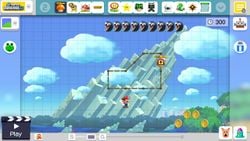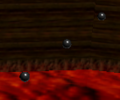Track
It has been requested that this article be rewritten and expanded to include more information. Reason: Include more information about all appearances, such as the first level in which tracks appear in each game, and all obstacles that can appear along tracks
- This article is about the object mostly found in the Super Mario series. For the Super Mario Maker sample course that prominently features the object, see Tracks (level). For the event type in the Mario & Sonic series, see Athletics. For the enemy in Super Mario Galaxy and Super Mario Galaxy 2, see Tracks (enemy).
Tracks, also known as rails,[1] are objects found in many Super Mario games, debuting in Super Mario Bros. 3. They are paths drawn in the air on which objects—most commonly lifts but including other objects such as ? Blocks and enemies—travel. They can form closed loops, closed paths (where the object reverses direction upon reaching the end), or open paths (where the object leaves the track to either fly onto another track or simply fall).
History
Super Mario series
Rails first appear in World 1-6 of Super Mario Bros. 3. They are always found with a lift connected to them, and unlike untracked lifts, these ones move along the set path; some of them (such as the first two in World 3-2) start moving only once Mario or Luigi jumps on them. Some rails feature endpoints known as motors.[2] If a rail has a motor at the end, the lift will reverse its movement direction once it reaches the motor. If there is no motor, the lift will fall off the rail upon reaching its end.
Starting from Super Mario World, enemies and obstacles (such as Fuzzies and Chainsaws) start appearing on tracks, behaving similarly to lifts.
In certain three-dimensional games, such as Super Mario 64, tracks are represented by a broken chain of flame throwers that disappear once passed.
In Super Mario 3D Land and Super Mario 3D World, parallel pairs of tracks hold Switchboards, as well as the Fuzzler enemy. Singular tracks still sometimes have Fuzzies on them.
Tracks can also be used as objects in Super Mario Maker and Super Mario Maker for Nintendo 3DS. They can be produced in eight directions, and they can be made into one-way paths when connected to each other as is or loops when connected back to the start. If the player places an object on a track, it will move along the set path. The direction in which the object moves initially can also be set. On a non-looped path, once an object reaches the end, it goes back the other way; however, tapping on one of the two endpoints makes it disappear, causing any objects that reach the end to fall off the track instead. If the player shakes a track, it will make it rounded. Doors and large-scale objects such as Mushroom Platforms and Warp Pipes cannot be placed on tracks. Objects placed on tracks almost never interact with untracked objects, with the exception of Mario and most enemies. For example, if blocks of any variety are placed on a track and derails off it, they will pass through ground and untracked blocks, but they will collide with an enemy and defeat it, including Bowser Jr. and Bowser but not Boos and Bloopers.
Tracks return as course elements in Super Mario Maker 2. Some tracks can have their position changed by using ON/OFF Switches.
Yoshi franchise
Yoshi's Story
In Yoshi's Story, tracks appear in the level Rail Lift, where they carry smiling cloud platforms. Octagonal objects with levers attached, known simply as switches, are present along the tracks. A Baby Yoshi can hit a switch with an egg to change the path of the track.
Yoshi Topsy-Turvy
Rails return in Yoshi Topsy-Turvy. The player can move lifts across these rails by tilting their Game Boy Advance.
Wario Land series
In the Wario Land series, tracks appear in Wario Land 4 and Wario Land: Shake It! infrequently, working as they have in past titles.
Donkey Kong Country: Tropical Freeze
Tracks also appear in Donkey Kong Country: Tropical Freeze, primarily in the level Platform Problems.
Gallery
Super Mario Maker (Super Mario Bros. style)
Super Mario Maker (Super Mario World style)
Super Mario Maker (New Super Mario Bros. U style)
Super Mario Maker 2 (Super Mario Bros. style)
Profiles
Super Mario Maker for Nintendo 3DS
- Digital manual description: "Select Track from the palette, and then touch the screen to lay it. Tracks can be laid in up to eight directions. The directions you can lay a track in will be displayed as dots to be joined. Drag an enemy or other element onto the track, and it will move along the path you've created. Tap the end point of a track to switch it between the returning- and dead-end types."
Names in other languages
| Language | Name | Meaning | Notes |
|---|---|---|---|
| Japanese | レール (Super Mario Bros. 3[3] and Super Mario Maker 2) Rēru |
Rail | |
| 一線[4][page number needed] (New Super Mario Bros.) Issen |
Line | ||
| Chinese | 轨道 (Simplified) 軌道 (Traditional)[?] Guǐdào |
Rail/Track | |
| Dutch | Rail (Super Mario Maker 2) Spoor[5] |
Rail Track |
|
| German | Schiene[?] | Rail | |
| Italian | Binario[?] | Track | |
| Korean | 레일[7] Reil |
Rail | |
| Portuguese (NOE) | Faixa[6] | Track | |
| Russian | Рельс[?] Rel's |
Rail | |
| Spanish | Riel[?] | Rail |
References
- ^ Super Mario Bros. 3 English instruction booklet, page 19.
- ^ "Rail Lifts with motors are safe to stay on, but those without will fall off the screen upon reaching the end of the line." – Nintendo Power Strategy Guide: Super Mario Bros. 3, page 14.
- ^ Super Mario Bros. 3 Japanese instruction booklet, page 17.
- ^ Shogakukan. 2015. Sūpā Mario Burazāzu Hyakka: Nintendō Kōshiki Gaido Bukku, New Super Mario Bros. section
- ^ Nintendo Nederland (May 15, 2019). Super Mario Maker 2 Direct - 16 mei 2019. YouTube. Retrieved May 16, 2019.
- ^ Nintendo Portugal. (May 15, 2019). Super Mario Maker 2 Direct - 15/05/2019. YouTube. Retrieved January 10, 2021.
- ^ 한국닌텐도 공식 채널 (May 16, 2019). 슈퍼 마리오 메이커 2 Direct 2019.5.16. YouTube. Retrieved November 11, 2022.





